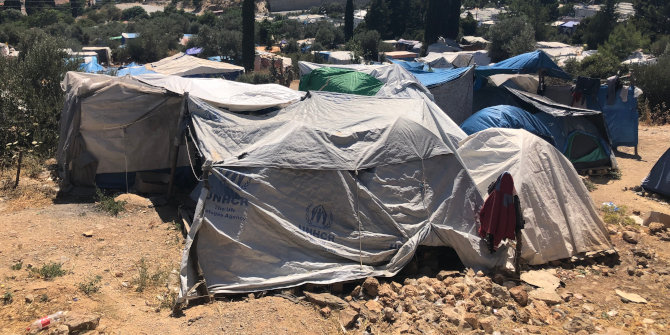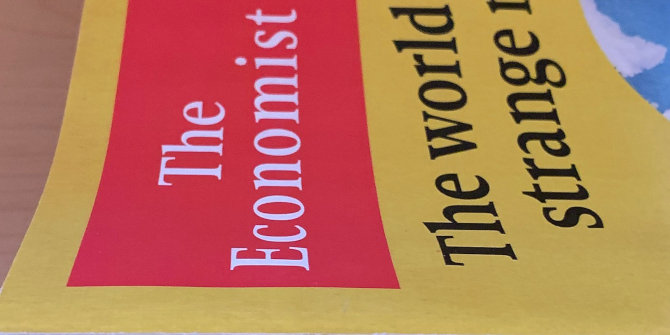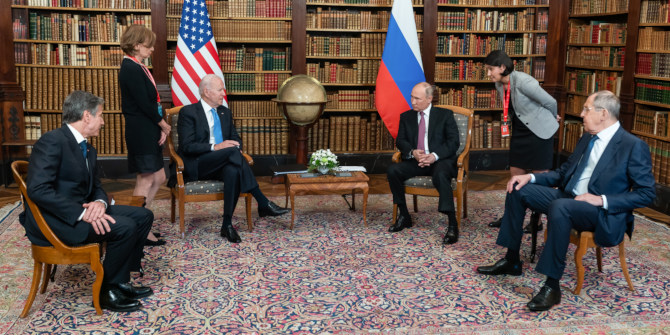Efforts to solve conflict and establish peace across the world have evolved into what might be called an ‘international peace architecture’. Oliver P. Richmond tracks the six stages through which this system has emerged and asks whether it is still capable of responding to the demands of modern conflicts.
During the last century, the evolution of an ‘international peace architecture’, which dates back at least as far as the Duc de Sully’s ‘Grand Design’ in the 17th century, has encompassed the local, state, regional, and global scales of international relations. But what does this peace architecture entail and how has it been created?
Every political system requires complex systems to maintain its legitimacy, including knowledge, power, the ability to innovate, provide inter-generational maintenance, and reflect everyday political claims for order, progress, and sustainability. The international peace architecture was formed through parallel processes to combat war and violence, through global, regional and state frameworks, and in local and transnational processes involving a complex development and expansion of rights. There were six key stages in its development.
Stages one to four
Stage one emerged from the balancing system of 19th century geopolitics, which allowed limited progress to be made on the basis of a fragile, imperial balance of power. This laid the basis for stage two, after the First World War, when the American backed liberal internationalist system was built. International law, new forms of diplomacy, democracy, and growing multilateralism, consolidated the international peace architecture during the 20th century.
Stage three spanned the Marxist challenge to imperialism, capitalism, and liberalism, drawing on the revolutionary philosophies of the French and American revolutions, the Soviet Union’s vision of international peace, as well as the growing demands made by newly colonial states by the 1960s (including the Non-Aligned Movement this spurred). Stage three resulted in the Cold War balance of power and ideological, developmental stalemate.
It also provided a platform for global networks focused on matters of peace and justice to expand into civil society, science and technology, trade, law, conventions, and treaties by the 1970s. As multilateral and regional institutions developed over the latter half of the century, an important convergence arose with the Helsinki Accords of 1975. They connected foreign policy, human rights, and the constitution of a European and potentially global order, which capitalised on the international peace architecture.
These dynamics led to stage four after the end of the Cold War. This stabilised the existing layers of the architecture while enormously expanding its overall scope. It required a much higher set of standards. The ‘Agenda for Peace’, published by the UN Secretary General in 1992, linked “…social progress and better standards of life in larger freedom” with prevention, peacekeeping, and peacebuilding as well as disarmament, drawing stages one to four together.
The international peace architecture now included the UN, NATO, the EU, AU, and other regional organisations, as well as the international financial institutions, the various international courts and law, the donor systems, social movements, and a multiplying range of NGOs. In addition, it supported a constitutional model, a system of international law, and inter-governmental institutions in a complex web of interdependence, norms, and standards.
The international peace architecture, by this point, was becoming aligned with social claims for security, rights, welfare, and justice, as well as more complex identities. This process positioned a layer of liberal internationalism upon the 19th century ‘balance of power’ system, creating the possibility for the mitigation of imperial and state-centric war, as well as civil war.
Through this process, subaltern claims were represented in several waves through stages two, three and four, to the limited degree allowed by existing knowledge-power structures. Public goods emerged to maintain peace and order through institutions, law, development and legitimacy, their effects spilling across local to global scales. Stage four enabled claims for rights and justice to expand substantially, also reducing more revolutionary pressures on the international system.
Stages five and six: Growing instabilities
By stage four, the international peace architecture ran on a very low margin of reserve capacity drained by its scale and its complex processes. This meant intervention (broadly defined as military, peacekeeping, mediation, peacebuilding, and development), the reform of the state, and civil peace formation processes came to operate within the framework of preserving states and only the most basic of rights, known as the ‘stabilisation’ approach (as in Syria since 2011).
The 2000s therefore saw the rise of an authoritarian and neoliberal peace in stage five of the international peace architecture, focused on limited statebuilding and basic regional security. It was supported by global capital in the hope that this would buttress the development of legitimate authority in conflict-affected environments like Afghanistan and Iraq. It was supported by the West for geopolitical reasons, yet was undermined by its growing lack of political will. It was also partially supported by the emerging powers such as China and India for reasons of trade and regional influence.
Stage five was careless with the legitimacy of the existing international peace architecture, turning to neoliberal, technological, and military hegemony. This strategy undermined the entire architecture as well as the micro-processes within it (such as peacekeeping, peacebuilding, development, and mediation).
Stabilisation strategies risked abandoning previous layers of the international peace architecture. They offered little in the way of a response to new modes of war, now experienced as piecemeal, disaggregated, multiple phenomena: from the complex, regional and civil war in Syria, to guerrilla warfare as recently ended in Colombia and urban violence of the kind seen in Latin America in particular, or the low-level conflict across the MENA region, sub-Saharan Africa (as in the DRC), and South-East Asia (as in Cambodia) over misallocation under authoritarian regimes.
With the arrival of the peacebuilding doctrine in the 1990s, broader strategies that were expected to deal with deeper instabilities and injustices also ironically preserved the northern dominated hierarchy. They increasingly blocked structural reform, and the expansion of rights and justice, more recently flirting with dismantling much of the international peace architecture.
Stage six of the architecture would inevitably require intellectual innovation, and material and geopolitical investment, support for rights expansion and transversal dynamics to reflect subaltern claims (in line with the UN Sustainable Development Goals (2015)). Democratising the international adds a concern with global inequalities and long-term sustainability, as raised by global civil society networks, as well as emancipatory global governance linked to global cooperation and justice. Such a trajectory points to deep relationality across societies and the deep structures of the environment or commons.
Stage six might reflect the long process of ‘rights-seeking’ across cultural, political, social, and economic terrains, pushing beyond a core-periphery, neo-colonial or neoliberal political economy. It highlights two processes, one a linear process of liberal institution and constitution building, perhaps leading to some sort of global federation, and secondly the micro-powers that actualise subaltern political claims, via a networked, transversal process, leading to more decentralised systems of governance. This points to complex forms of peace that support reconciliation, equality, justice and sustainability across issue areas, networks, and scales.
However, more negative alternatives are also on the horizon. The mounting contradictions and failures of the previous layers have meant that stage six is clearly bifurcated, limiting its capacity to stabilise the existing layers of the international peace architecture or deal with the newer dynamics driving war and conflict. Its alternative path points to a ‘pax technica’: a hybrid of neoliberalism and new technologies of power, extending many of the older, predatory patterns of elite political power, which might be termed ‘digital governmentality’. It may refresh variants of stages one and five (geopolitics and statebuilding / stabilisation), and reject or dilute expanded rights and scientific claims about sustainability and global justice.
Blockages and counter-peace
Internal tensions in the different elements of the international peace architecture ensured that it became more entrenched and difficult to reform as it expanded. It simultaneously addressed and provoked revanchist and counter-revolutionary forces associated with systems of geopolitics, nationalism, race, class, gender, and capital, as well as challenges to them. It involved confronting and challenging existing vested power structures, and its capacity is very much reactive.
Peace is formed after war and conflict due to a mix of social and elite forces, and it is not able to anticipate the nature of future wars because of its limited capacities. Stage four’s global scale also meant it faced the charge of inconsistency in maintaining a common, normative order (see the cases of Syria since 2011 and Rwanda in 1994 versus say Kosovo and Bosnia in the late 1990s). It was soon opposed by traditional power alignments (class, capital, state, and geopolitics) as well as by the emerging ‘great powers’ and decolonial justice-oriented challenges from the Global South. This array of blockages hindered peacebuilding processes and constituted a substantial counter-peace framework.
The example of peacebuilding in Bosnia and Herzegovina is illustrative. Since the 1995 Dayton Peace Accords, dominant power structures have been revived. These seemingly ad hoc dynamics have blocked reforms, stopped the expansion of civil society, and pushed back the rule of law. They have also limited the scope for action of the Office of the High Representative, making it very difficult to move beyond the limited Dayton Agreement.
Bosnia’s progress towards EU accession has stalled because offending power-structures were supported by rents received from ethno-nationalism, territorialism, secessionism, militarism, as well as the gains made from unregulated capital. The UN, EU, and other organisations supported stabilisation policies as a result, enabling continuity in public office, and institutions, reflecting elite power. These counter-peace dynamics neutralised the already weak liberal peacebuilding framework. Reconciliation has been replaced by entrenchment, which may slide back towards conflict without decisive regional and international engagement.
This reiterates a familiar, contemporary story: that conflict requires peacemaking systems to be embedded in social, state, regional and international frameworks. If they become derailed or collapse because of ad hoc blockages or more purposive counter-peace challenges, the international peace architecture systems will need to be reinvented or reinvigorated, starting the cycle once more.
The future of the international peace architecture
Overall, the international peace architecture represents an attempt to respond to the aftermath of different types of war while maintaining western and northern hegemony, yet also to support the construction of a social state. These goals are contradictory: the international peace architecture combines both emancipatory and hegemonic frameworks, in which ideological contestation has not been resolved. It represents a reactive architecture that mainly evolves after new dynamics of war and violence threaten the international system.
Yet, each stage is also a vehicle for the expansion of subaltern and human rights claims across the international system, which has influenced the development of the social contract, the nature of the state, and international order itself. This is reflected in the UN’s recent Sustaining Peace agenda. The international peace architecture now connects peace with scientific positions far beyond those suggested by geopolitics, the nation state, or western-dominated elite multilateralism.
It is perhaps for these reasons that counter-peace retrenchments, combined with new forms of conflict, have appeared to overwhelm the capacity of the international peace architecture as it is currently constituted. This raises a contemporary policy and intellectual question for those working in and on international relations: how might reactionary forces connected to the newer dynamics of war be tamed by another layer of the international peace architecture, while at the same time stabilising the entire, complex, and fragile edifice?
For more information, see the author’s accompanying paper in the European Journal of International Security and forthcoming book, The Grand Design (Oxford University Press)
Note: This article gives the views of the author, not the position of EUROPP – European Politics and Policy or the London School of Economics. Featured image credit: UN Photo/Violaine Martin (CC BY-NC-ND 2.0)





